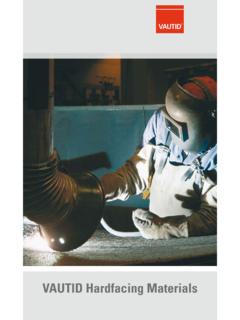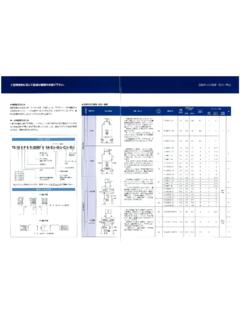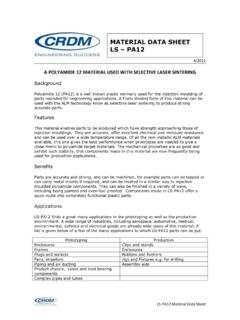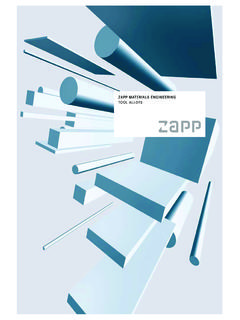Transcription of Compacted Graphite Iron A New Material for Highly …
1 Compacted Graphite Iron A New Material for Highly stressed cylinder Blocks and cylinder Heads SinterCast 2012 1 Compacted Graphite Iron A New Material for Highly stressed cylinder Blocks and cylinder Heads Vermicular-Graphit-Guss: Ein neues Material f r h chst beanspruchte Motorbl cke und Zylinderk pfe Dr Steve Dawson, SinterCast Ltd, London Prof. Fritz Indra, Honorary Professor, Vienna University of Technology Abstract The demands for downsizing and power-up continue to pose challenges for engine designers and for the materials they choose. The present state-of-the-art for Highly charged diesel engine performance is 60-65 kW/litre and 150 Nm/litre. This is forecast to rise to 80 kW/litre and 200 Nm/litre in the next generation of DI diesel engines and will surely reach 100 kW/litre during the next decade.
2 These performance demands will result in significant increases in thermal and mechanical loading and will require new Material solutions. The application of Compacted Graphite Iron (CGI) provides approximately double the fatigue limit of conventional grey iron and aluminium alloys and therefore satisfies bottom- end durability requirements without increasing the size or weight of the main bearing region. The strength and stiffness of CGI also improve the dimensional stability of the cylinder bore to reduce piston slap, bore wear, oil consumption and blow-by. The present paper provides a review of CGI Material properties, engine results and comparisons to grey iron and aluminium to show how CGI can contribute to future performance, refinement and emissions objectives.
3 Zusammenfassung Die Entwicklung zu immer mehr Leistung sowie die Verkleinerung der Verbrennungskraftmaschinen ist eine besondere Herausforderung f r die Entwicklungsingenieure, sowie das Material das dabei verwendet werden sollte. Zurzeit haben hoch-aufgeladene Diesel-Motoren eine Literleistung von 60-65 kW sowie ein Literdrehmoment von 200 Nm. Es ist abzusehen, dass die n chste Generation der Diesel-Motoren bis zu 80 kW/Liter sowie 200 Nm/Liter erreichen werden. In fernerer Zukunft sollten sogar 100 kW/Liter m glich sein. Die dabei sehr hohen thermischen und mechanischen Beanspruchungen erfordern neue L sungen auf der Materialseite. Bei der Verwendung von Vermicular-Graphit-Guss (CGI) kann mit doppelt so hohen Beanspruchungen gerechnet werden wie bei normalem Grauguss, oder Aluminium Legierungen.
4 So k nnen mit CGI alle Anforderungen modernster Diesel-Motoren erf llt werden, ohne dass dabei die Gr e oder das Gewicht zunehmen muss. Die Festigkeit und Steifigkeit von CGI verbessert auch die Stabilit t der Zylinderbohrung und f hrt so zu weniger Kolbenverschlei und Kolbenger uschen, reduzierter Reibleistung, verringertem lverbrauch und weniger blow-by Gasen. Dieser Vortrag erkl rt die Material -Eigenschaften von CGI und zeigt Ergebnissen im Vergleich zu Motoren aus Grauguss und Aluminium und macht klar wie CGI den zuk nftigen Leistungs-Anforderungen von h chstbeanspruchten Verbrennungskraftmaschinen gen gen kann. 2 Introduction Although Compacted (vermicular) Graphite Iron was first observed in 1948, the narrow range for stable foundry production precluded the high volume application of CGI to complex components such as cylinder blocks and heads until advanced process control technologies became available.
5 This, in turn, had to await the advent of modern measurement electronics and computer processors. Following the development of foundry techniques and manufacturing solutions throughout the 1990 s, the first series production of CGI cylinder blocks began during 1999. Today, more than 40,000 CGI cylinder blocks are produced each month for OEMs including Audi, DAF, Ford, Hyundai, MAN, Mercedes, PSA and Volkswagen. Emissions legislation and the demand for higher specific performance from smaller engine packages continue to drive the development of diesel engine technology. While higher peak firing pressures provide improved combustion, performance and refinement, the resulting increases in thermal and mechanical loads require new design solutions. Design engineers must choose between increasing the section size and weight of conventional grey iron and aluminium components or adopting a stronger Material , specifically, CGI.
6 Given that new engine programs are typically intended to support three to four vehicle generations, the chosen engine materials not only need to satisfy current design criteria but must also provide the potential to satisfy future emissions and performance objectives, without changing the overall block architecture. With at least 75% increase in ultimate tensile strength, 40% increase in elastic modulus and approximately double the fatigue strength of either grey iron and aluminium, CGI is ideally suited to meet the current and future requirements of engine design and performance. Microstructure and Properties As shown in Figure 1 (a), the Graphite phase in Compacted Graphite Iron appears as individual worm-shaped or vermicular particles. The particles are elongated and randomly oriented as in grey iron, however they are shorter and thicker, and have rounded edges.
7 While the Compacted Graphite particles appear worm-shaped when viewed in two dimensions, deep-etched scanning electron micrographs (Figure 1 (b)) show that the individual worms are connected to their nearest neighbours within the eutectic cell. The complex coral-like Graphite morphology, together with the rounded edges and irregular bumpy surfaces of the Compacted Graphite particles, results in stronger adhesion between the Graphite and the iron matrix, inhibiting crack initiation and providing superior mechanical properties. 3 The vermicular Graphite particles in CGI are connected to their nearest neighbours in coral-like clusters. Die Vermiculargraphit-Partikel in CGI sind mit ihren n chsten Nachbarn in korallen-artigen Clustern verbunden. Compacted Graphite Iron invariably includes some nodular (spheroidal) Graphite particles.
8 As the nodularity increases, the strength and stiffness also increase, but only at the expense of castability, machinability and thermal conductivity. The microstructure specification must therefore be chosen depending on both the production requirements and the performance conditions of the product. For example, the production of CGI exhaust manifolds is typically specified with up to 50% nodularity. For manifolds, the higher nodularity provides increased strength to facilitate supporting the exhaust system and also increases the flow of exhaust heat into the catalyst to achieve early light-off. In this case, the higher nodularity benefits the product without increasing the incidence of casting defects or impairing machinability. However, in the case of cylinder blocks and heads, where castability, machinability and heat transfer are all of paramount importance, it is necessary to impose a more narrow specification.
9 A typical specification for a CGI cylinder block or head can be summarised as follows: 0-20% nodularity, for optimal castability, machinability and heat transfer No free flake Graphite , flake type Graphite (as in grey iron) causes local weakness >90% pearlite, to provide high strength and consistent properties < titanium, for optimal machinability This general specification will result in a minimum tensile strength of 450 MPa in a 25 mm diameter test bar, and will satisfy the ISO 16112 Compacted Graphite Iron standard for Grade GJV 450. The typical mechanical properties for this CGI Grade, in comparison to conventional grey cast iron and aluminium are summarised in Table : Figure 1: (a) CGI with 10% Nodularity Vermicular Graphit Guss mit 10% Nodularit t (b) Deep-etch SEM micrograph Deep-Etch-REM-Aufnahme 4 Table.
10 Mechanical and Physical Properties of CGI in comparison to conventional grey cast iron and aluminium at 20 C Material und physikalische Eigenschaften von CGI im vergleich zu konventionellem Grauguss und Aluminium bei 20 C Property Units GJV 450 GJL 250 GJL 300 A Ultimate Tensile Strength MPa 450 250 300 275 Elastic Modulus GPa 145 105 115 80 Elongation % 1-2 0 0 1 Rotating-Bending Fatigue (20 C) MPa 210 110 125 100 Rotating-Bending Fatigue (225 C) MPa 205 100 120 35 Thermal Conductivity W/m-K 36 46 39 130 Thermal Expansion m-m-K 12 12 12 18 Density g/cc Brinnell Hardness BHN 10-3000 215-255 190-225 215-255 110-150 Series Production References The successful development of CGI production and manufacturing technologies has resulted in series production programs in Europe, Asia and the Americas.






